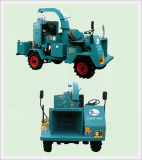Home » CNC Routers


CNC Router Quick Info:
What’s the difference between a CNC Router and a CNC Machining Center? Or a 4 axis CNC router and a 5 axis CNC router? Is there a difference, and if so, why do CNC machine users differentiate between the terms?
In understanding CNC routers, it helps to know what routing is in general. Routing is used for processes such as cutting, trimming or shaping, employing high rpm cutters, and on materials such as wood, light metals, plastics, and many other materials.
Routing as a process has usually been applied to relatively weak and brittle materials such as wood, while milling has been occupied with the work of metal cutting, requiring more power, slower cutting speeds and different tool geometry. Thus a CNC router would typically be defined by what it’s being used for: a CNC machine used to cut or shape wood is likely to be referred to as a CNC router rather than a mill.
History of CNC RoutersGiven the utility of the router, along with the progression and development of power tools of all sorts, it’s no surprise that the router’s versatile and indispensable characteristics took it on a direct path into a merger with CNC technology, where it gained innumerable benefits and added its own to the synergy of the two technologies.
As far as naming convention goes, it’s actually the nature of the material that’s being cut that tends to denominate the tool and not the tool itself. In the realm of CNC machining centers, the same machine (depending upon machine design) can cut either light or heavy materials, in one case being popularly called a “CNC router”, in the other a “CNC mill.”
As the application of CNC technology began to expand across machining equipment, questions arose about the correctness of various names and the distinctions between various types of CNC equipment. In general CNC technology is the application of the fundamentals of numerically controlled machine movement design – the blending of electronic controls, program code which describes the movement through 2D or 3D Cartesian space, well designed and rigid machine support structures taking into consideration momentum, mass, torsion, and various other mechanical concerns, precision motion hardware for ways, guides, racks and pinions, ball screws, and an electro-spindle at the end of the machine mast appropriate to the cutting processes involved and considering the tooling requirements.
5 Axis CNC RoutersThe growth of CNC machining technology to include computerized numerical control with CNC routers was a natural progression that led to CNC routers adding 5 axis routing capabilities to the machines. In general, any CNC machine that can move in four or more ways is called multiaxis machining. This would include the advent of new machining types like 5 axis CNC routers working on larger wood cutting projects and other similar machines and materials. The 5 axis CNC router invention has allowed for precision cuts in an efficient manner, as can be seen in the video above, which features a 5 axis CNC router working on beam and timber frame construction.
CMS began the application of CNC technology through their CNC routers to wood and other lighter materials in the early 1970’s and from this beginning has vastly expanded the capabilities and offerings in this sector as it complied with more and more customer requests such as:
Because of this versatility, CMS has always employed the name “CNC Machining Center”, rather than the more popular term CNC Router, in order to provide a reference point which doesn’t “pigeon-hole” its capabilities or restrict its application. With CMS, advanced CNC Routing capabilities are assured and a whole world of new opportunities remain open to the user, no matter what the changing demands of the “times” may be.
To learn more about CNC Routers, including our 4 and 5 axis CNC router capabilities, or to see what CMS North America can offer for your CNC router needs, contact us today with any questions.
,







